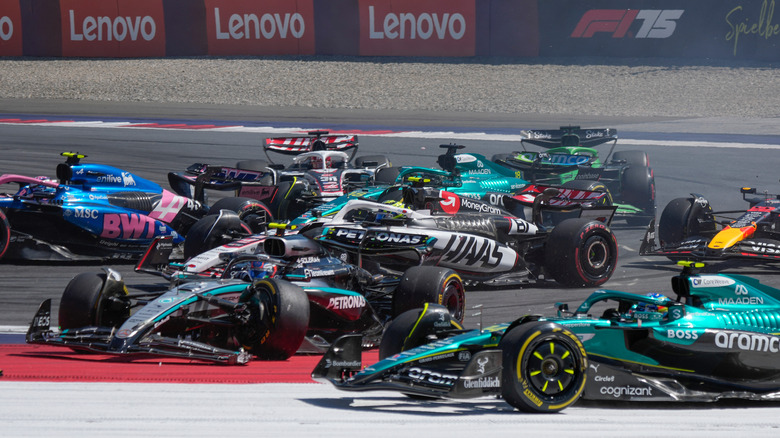
Formula 1 cars are engineered to shave milliseconds off lap times, so it's no surprise that even tires get the red-carpet treatment through the use of tire blankets. Those weird quilted covers you see wrapped around every set of Pirellis on the grid aren't just for show, however. They're heat guns in disguise, and they're crucial to making sure cars don't tiptoe out of the pits like baby deer on ice.
While Pirelli works on making the high-performance F1 tires more sustainable, their performance criteria remain the same and these tires just don't like the cold. Tire blankets preheat the rubber to a working temperature before it ever hits the track. In F1, that means heating rear tiers to somewhere around 158°F (70°C) for a couple of hours before a race starts and the cars exit the pits.
After all, cold tires are slippery tires, and in a sport where grip equals lap time, sending a car out on stone-cold rubber is like F1 but on an ice skating rink. You're going to lose grip, and probably a few front wings. So it turns out that preheating the tires isn't just about performance — it's a crucial safety measure.
 Guenther Iby/Getty Images
Guenther Iby/Getty Images
The whole point of a tire in racing is to provide grip, and grip is a temperature-dependent thing. The concept is simple — rubber when cold is brittle and rigid while higher temperatures make it more flexible. The more elasticity a tire has, the more contact it makes with the track as it deforms around the grooves of the surface. The rubber compound on F1 tires is designed to operate optimally at around 212°F (100°C). This is why you see drivers weaving around to get the tire temperatures up during the formation lap.
Tire blankets help get tires into that optimal range faster. Warmer tires generate more grip and thus provide better performance. When a car exits the pit lane on preheated rubber, the driver can push sooner and avoid a sketchy first-lap slide-fest that can happen with cold tires. Without blankets, drivers would have to spend more laps bringing tires up to temp.
For 2024, F1 was flirting with the idea of banning tire blankets in the name of sustainability, but after testing and feedback from teams, that rule change got bumped to at least 2025. Reigning World Champion Max Verstappen raised concerns about safety and tire wear if they had to warm tires purely through driving. In fact, tires are so crucial that Pirelli collects them back after a race weekend to evaluate them.
 ddproimages/Shutterstock
ddproimages/Shutterstock
Tire blankets aren't just fancy covers, they're high-tech heat wraps stuffed with heating coils and thermally conductive gel. Once plugged in, they hold temps like a champ, keeping that slick rubber warm and ready to grip the second it hits the tarmac.
Each tire blanket wraps snug around the entire wheel, locking in heat across every inch of rubber. Once all four are fitted, they're wired up to a control box that acts like a pit lane thermostat, carefully managing the temp buildup. Of course, there are rules and F1 takes them very seriously. Slicks can only be preheated for two hours, max, at 158°F (70°C). Intermediates get the same time limit but cap out at 140°F (60°C). As for full wets? No blanket time at all. If it's raining, you're going out cold. Pirelli did introduce new wet weather tires that came into effect in 2023, but they don't need heated blankets.
F1 multi-colored tire compounds are complex components and yes, tire blankets on them may look like glorified electric duvets, but they're just as vital to performance and safety in F1. They ensure cars launch out of pit boxes with confidence and control, ready to grip and rip at full tilt.














